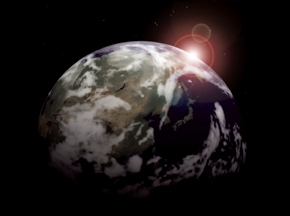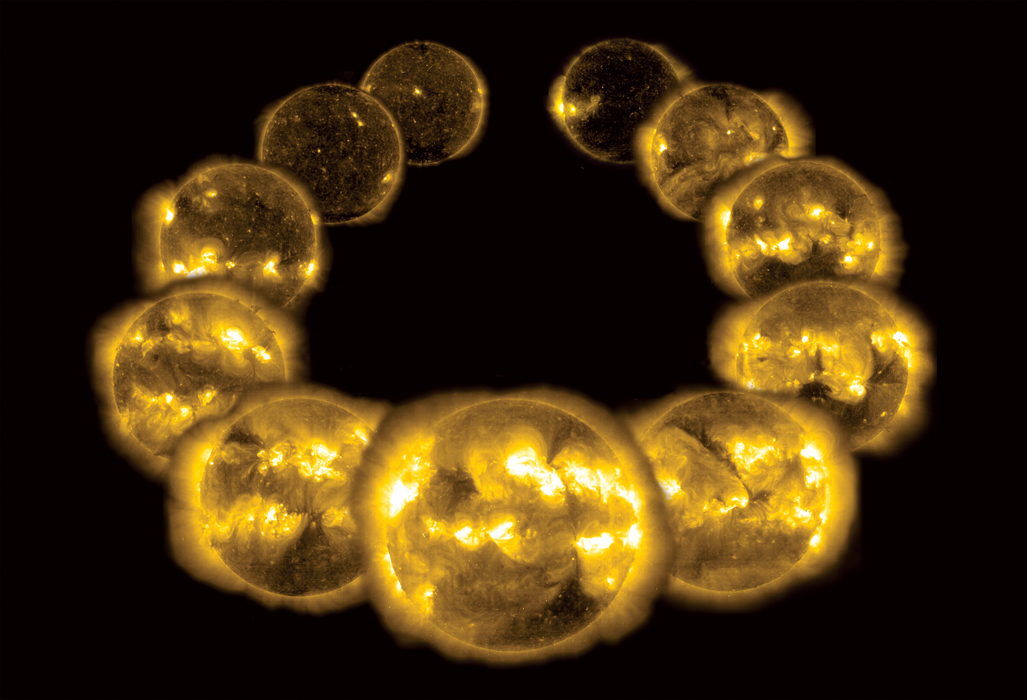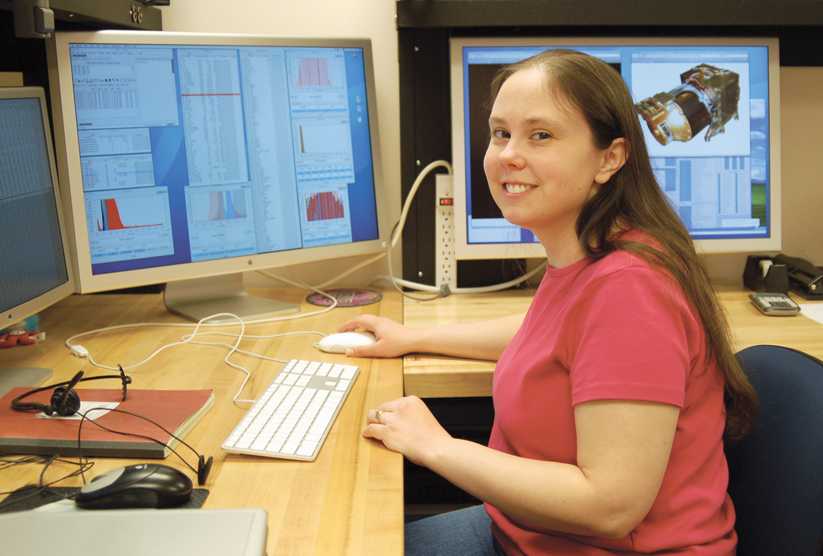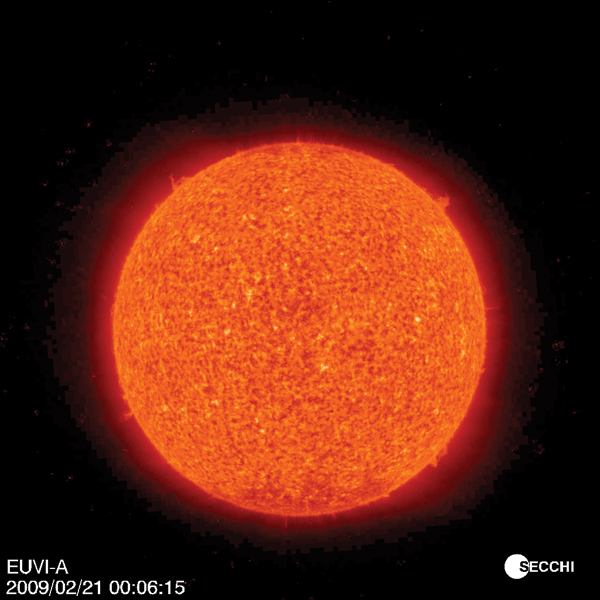Here Comes the Sun, Not!
WHEN NASA’s TWIN STEREO satellites rocketed into space back in October of 2006, doctoral student Kristin Simunac was looking forward to the rich, three-dimensional data the Sun-orbiting observatories would gather on coronal mass ejections – the focus of her dissertation. Our star, however, had other plans, so Simunac had to change hers.
STEREO, with the UNH-built Plasma and Suprathermal Ion Composition (PLASTIC) instrument onboard, was launched near the tail end of solar minimum. This quiet period is when the Sun is least active – compared to solar maximum – but still detonates the occasional coronal mass ejection.
However, during this particular minimum period, the Sun has been practically comatose. In fact, it’s been the sleepiest cycle in the 50 years since the space age began. So instead of waiting for the Sun to wake up to carry on with her Ph.D., Simunac changed her focus to the quiet side of things – specifically a phenomenon known as corotating interaction regions.
These regions are ubiquitous, spiral-shaped masses of plasma where the two different types of solar wind emanating from the rotating Sun – fast and slow – collide. This collision creates an area of increased temperature and density as fast solar wind pushes into its slow counterpart.
Says Simunac, “The analogy I like to use for corotating interaction regions is what happens in New England when leaf peepers are out on the road and suddenly up from behind come the commuters. The leaf peepers can either speed up or get out of the way…the overall traffic density increases, tempers flare, heat rises.”
It is because of this build up in density and temperature that the interaction regions have been identified, but the actual geometry, known as a Parker Spiral, is purely theoretical. “This spiral picture is fine in theory but until now it’s been difficult to experimentally verify that’s really what’s going on,” says Simunac.
Now, with STEREO providing the first three-dimensional views of the Sun and its activities, a more detailed picture will emerge of just what these corotating regions look like.
This clearer picture will, among other things, provide a better understanding of the “background medium” through which the more explosive coronal mass ejections and solar flares – the primary components of “space weather” – must travel.
All of this solar energy, including the less intensive corotating regions, can disrupt and damage Earth-orbiting satellites, Earth-bound technologies and power supplies, and can pose a danger to astronauts as well as aircraft at Earth’s polar regions. Knowing the structure of all this solar plasma barreling towards Earth and beyond will allow better predictive capabilities when an explosive event takes place on the Sun.
Says Simunac, “One thing we’re trying to figure out is the limit under which we can assume the Parker Spiral geometry is reasonable – because modelers have to put in some assumptions and the fewer assumptions the more accurate the model can be.” And, in turn, the more accurate space weather predictions can be.
The STEREO spacecraft, which after two years in orbit reached a 90-degree separation on January 24, provide the perfect perch from which to study the “before and after” shifting shapes of the corotating interactive regions as they spin away from the Sun. (The same can be said, of course, about the twin spacecraft taking measure of coronal mass ejections and solar flares from widely separated orbits.)
Simunac notes that should the Sun remain unusually quiet as the STEREO mission proceeds there will be some disappointment, since mission scientists hoped to study the Sun’s more explosive side from the new, three-dimensional view.
“But it’s also good to understand the supposedly simpler case,” Simunac says, “this gives us a good opportunity to better understand the Sun’s quiet time.”
Indeed, says Toni Galvin, UNH’s principle investigator for STEREO-PLASTIC, some interesting data on particle acceleration is being gathered by another graduate student, Josh Barry, while the Sun slumbers.
“Josh’s work includes looking at ionized particles that are being accelerated or energized within the compression areas of the corotating interaction regions as well as particles that have been accelerated near the Earth’s bow shock and then shot past the STEREO spacecraft,” says Galvin. (Earth’s “bow shock” is the region where our planet’s magnetic field or magnetosphere meets the solar wind.)
These bow shock events would likely not be identifiable if there was a lot of other particle activity going on during a more active solar period. The significance of the finding, Galvin notes, is that bow shock events at these distances have never been identified before STEREO and were thought to be impossible. “What Josh’s work means is that particles being accelerated near the Earth are being tracked into the heliosphere for vaster distances than previously expected.”
STEREO, with the UNH-built Plasma and Suprathermal Ion Composition (PLASTIC) instrument onboard, was launched near the tail end of solar minimum. This quiet period is when the Sun is least active – compared to solar maximum – but still detonates the occasional coronal mass ejection.
However, during this particular minimum period, the Sun has been practically comatose. In fact, it’s been the sleepiest cycle in the 50 years since the space age began. So instead of waiting for the Sun to wake up to carry on with her Ph.D., Simunac changed her focus to the quiet side of things – specifically a phenomenon known as corotating interaction regions.
Composite of extreme ultraviolet images of the full solar maximum cycle from 1996 to 2006 (counterclockwise from upper left) taken by the Solar and Helipspheric Observatory (SOHO).
Image courtesy of NASA and ESA
|
Says Simunac, “The analogy I like to use for corotating interaction regions is what happens in New England when leaf peepers are out on the road and suddenly up from behind come the commuters. The leaf peepers can either speed up or get out of the way…the overall traffic density increases, tempers flare, heat rises.”
It is because of this build up in density and temperature that the interaction regions have been identified, but the actual geometry, known as a Parker Spiral, is purely theoretical. “This spiral picture is fine in theory but until now it’s been difficult to experimentally verify that’s really what’s going on,” says Simunac.
Now, with STEREO providing the first three-dimensional views of the Sun and its activities, a more detailed picture will emerge of just what these corotating regions look like.
This clearer picture will, among other things, provide a better understanding of the “background medium” through which the more explosive coronal mass ejections and solar flares – the primary components of “space weather” – must travel.
All of this solar energy, including the less intensive corotating regions, can disrupt and damage Earth-orbiting satellites, Earth-bound technologies and power supplies, and can pose a danger to astronauts as well as aircraft at Earth’s polar regions. Knowing the structure of all this solar plasma barreling towards Earth and beyond will allow better predictive capabilities when an explosive event takes place on the Sun.
Kristin Simunac Photo by K.Donahue, UNH-EOS |
The STEREO spacecraft, which after two years in orbit reached a 90-degree separation on January 24, provide the perfect perch from which to study the “before and after” shifting shapes of the corotating interactive regions as they spin away from the Sun. (The same can be said, of course, about the twin spacecraft taking measure of coronal mass ejections and solar flares from widely separated orbits.)
Simunac notes that should the Sun remain unusually quiet as the STEREO mission proceeds there will be some disappointment, since mission scientists hoped to study the Sun’s more explosive side from the new, three-dimensional view.
“But it’s also good to understand the supposedly simpler case,” Simunac says, “this gives us a good opportunity to better understand the Sun’s quiet time.”
An image of a "quiet" Sun taken by STEREO's Sun Earth Connection Coronal and Heliospheric INvestigation (SECCHI) on February 21, 2009. Image courtesy of NASA |
Indeed, says Toni Galvin, UNH’s principle investigator for STEREO-PLASTIC, some interesting data on particle acceleration is being gathered by another graduate student, Josh Barry, while the Sun slumbers.
“Josh’s work includes looking at ionized particles that are being accelerated or energized within the compression areas of the corotating interaction regions as well as particles that have been accelerated near the Earth’s bow shock and then shot past the STEREO spacecraft,” says Galvin. (Earth’s “bow shock” is the region where our planet’s magnetic field or magnetosphere meets the solar wind.)
These bow shock events would likely not be identifiable if there was a lot of other particle activity going on during a more active solar period. The significance of the finding, Galvin notes, is that bow shock events at these distances have never been identified before STEREO and were thought to be impossible. “What Josh’s work means is that particles being accelerated near the Earth are being tracked into the heliosphere for vaster distances than previously expected.”
by David Sims, Science Writer, Institute for the Study of Earth, Oceans, and Space. Published in Winter 2009 issue of EOS .



